
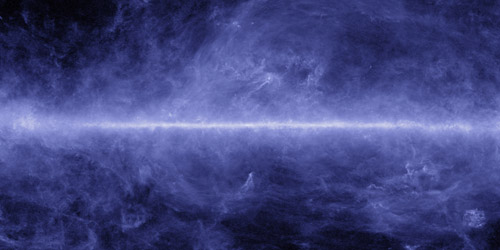
Most of the dust seen by Planck is very cold, at temperatures as low as around −260 C, and as a result glows in Planck's high frequencies (particularly 353 GHz and above). It is cold, dense clumps of dust and gas that mark the earliest stages of the birth of stars.
Although the dust is concentrated in the disc of our Galaxy, Planck has mapped its distribution all over the sky, showing structure at high Galactic latitudes (looking up or down out of the plane) of the Galaxy. Many other galaxies also contain similar dust, but most of them have been removed from the map of dust shown here.
The emission from the dust seen by Planck must be removed from the maps before cosmological analysis, but is of great interested to astronomers studying star formation in our own Milky Way.

The cold dust grains in our galaxy are aligned to the magnetic field, and this causes the light it emits to be slightly polarised. The direction of this polarisation tells us the orientation of the Galaxy's magnetic field.
The texture used to display the polarisation direction was originally produced by Marc-Antoine Meville-Deschenes (IAS Paris).
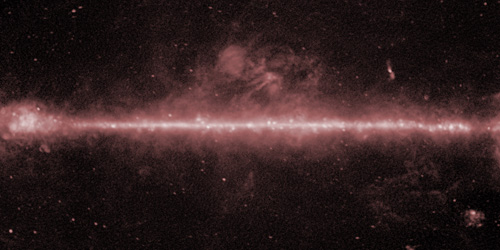
The "low frequency" foregrounds include a number of types of emission. Most of it is due to high energy electrons moving through the Galactic magnetic field (a phenomenon called "synchtrotron emission", and the rest is predominantly the emission from slower electrons moving through hot, ionised gas (a phenomenon called "Bremsstrahlung" or "free-free" emission). These phenomena cause strong emission at Planck's lowest frequencies (particularly 70 GHz and below). Most of the emission if located along the plane of our Galaxy, with the other bright spots primarily being galaxies beyond our own.
A small fraction of the microwave light is not accounted for by either of these methods, and is called "anomalous microwave emission". Planck has previously given a great deal of weight to the favoured theory, in which this enomalous emission is from tiny particles of dust spinning billions of times per second.
All of this emission is removed from the maps before the cosmological analysis, but it is of great interest to astronomers investigating the properties of our own Galaxy. With more analysis, and the inclusion of more information from other experiments, it should be possible to separate this single "foreground" into its constituent components.
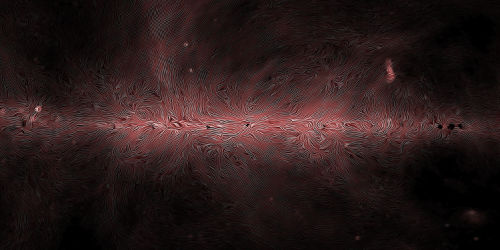
The "low frequency" foregrounds include a number of types of emission. Most of it is due to high energy electrons moving through the Galactic magnetic field (a phenomenon called "synchtrotron emission", and the rest is predominantly the emission from slower electrons moving through hot, ionised gas (a phenomenon called "Bremsstrahlung" or "free-free" emission). These phenomena cause strong emission at Planck's lowest frequencies (particularly 70 GHz and below). Most of the emission if located along the plane of our Galaxy, with the other bright spots primarily being galaxies beyond our own.A small fraction of the microwave light is due to tiny dust grains, spinning billions of times per second.
Of these three mechanisms, the synchroton emission is polarised, as the light is oriented to the direction of the magnetic field. This means that the synchroton emission maps out the magnetic field in our galaxy projected onto the sky, though the 3D structure is harder to deduce.
In the "colourised" version of the polarisation image the polarisation direction is indicated by the magnetic field direction (red = vertical, blue = horizontal).
The colourised image was made by Paddy Leahy (University of Manchester).
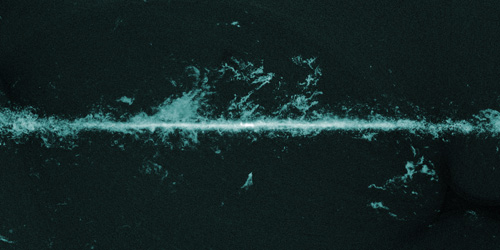
Most of the cold gas in our Galaxy is made of hydrogen, which only shines brightly at the frequencies seen by Planck when it is very hot. However, there are other "tracer" gases that do emit light at appropriate frequencies, such as carbon monoxide (CO). By carefully looking for the signs of emission by CO at 115, 230 and 345 GHz, Planck has produced the best all-sky map of this gas throughout our Galaxy.
The carbon monoxide is, as expected, largely concentrated in the Galactic Plane, though there are a number of molecular clouds which shine brightly at these frequencies. Planck's sensititivity has allowed it to detect some very diffuse clouds that had not been seen before.
The dark regions near the ecliptic poles are because Planck's maps are more sensitive in these regions, reducing the noise, or "graininess", in the images. The emission from carbon monoxide must be removed from Planck's maps before the comsological analysis, since any contamination could skew the results.

To do the cosmological analysis, any "contamination" from sources of light other than the CMB (primarily our Galaxy and others) must be removed. Although the Planck data can be used to make maps of the various other sources of light and correct for it, this is much more difficult to do in the centre of our Galaxy, and near the brightest sources of light around the rest of the sky. The "sky mask" shows the areas of sky that are not considered when doing the cosmological analysis, with those expluded from just the polarisation analysis shown in grey.

As well as the light from the Cosmic Microwave Background, and from diffuse dust annd gas in our own Galaxy, Planck also sees seemingly small objects dotted all over the sky. Some of these really are small, such as clumps of gas and dust in the process of forming stars. But others are simply very far away, such as other galaxies.
The map of sources shown here is representative of the full range of sources, showing those seen at frequencies of 30GHz (red), 143 GHz (green) and 857 GHz (blue). The size of the dots is a measure of Planck's resolution at the different frequencies (the resolution is better at higher frequencies).
The 30GHz sources are distributed over the whole sky, indicating that they are generally distant galaxies. The galaxies seen by Planck at this frequency are emitting large amounts of radio waves, often due to the activity of the central black hole.
By contrast, the sources seen at 857 GHz are concentrated in the plane of our Galaxy, with a few in the Large and Small Magellanic Clouds and the Andromeda Galaxy (add the "Labels" to see where these are. These are clumps of dust, either in our Galaxy or in nearby ones.
To do the comological analysis, most of these source have to be taken into account, either by ignoring that relevant patch of the sky (see the "Sky Mask") or by carefully removing the light associated with each source from the data before the full analysis is performed.
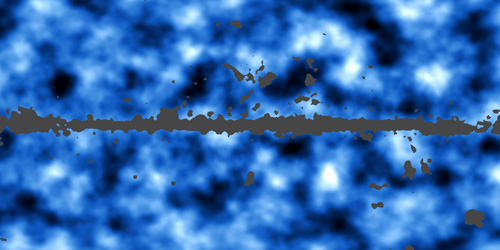
As the light from the CMB travelled through the Universe over the course of 13.8 billion years, most of it has been completely unimpeded. But there are very subtle effects caused by concentrations of mass in the Universe - most of which is in the form of mysterious dark matter. The gravitational pull of the mass distorts the image of the CMB, and these distortions can be mapped over the sky. These distortions are shown here, with large concentrations of mass showing up brighter.
The analysis depends on the assumptions about the patterns in the Cosmic Microwave Background itself, namely that on average all the hot-spots and cold-spots are circular. While that is true when averaging over the whole sky, it might not be the case when averaging over smaller regions, and some of the distortions are due to inherent variations in the original CMB light. There are also regions, particlarly in the Galactic Plane, but also around a few other objects, where the foregound light is so strong that it is not possible to calculate the mass distribution.